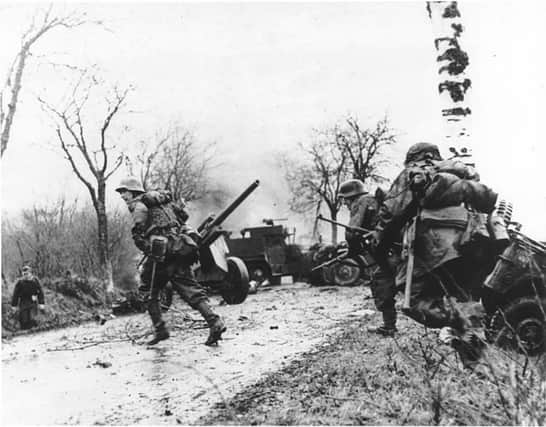Victory came at a heavy cost


Although the battle, between the Allies and the Germans during the Second World War, is little known today, it was crucial in the course of the conflict.
As Dorothy reveals, the British and their allies had to fight long and hard to make headway in the so-called forest of fear.
Advertisement
Hide AdAdvertisement
Hide Ad“As the battle progressed, on February 15, the 86th Field Regiment moved position once more,” explained Dorothy.
“They made their way from Cleve to the edge of the Reichswald Forest and took up positions around the village of Bedburg, which was uncomfortably close to enemy lines.
“Enemy mortaring was a problem to the gunners, but mercifully caused no serious casualties. The following day, the Canadians began their advance down the flooded area between the Cleve-Calcar road towards the Rhine and the regiment spent much of that day supporting them.
“When Goch was captured on the 21st, 86th Field Regt moved position closer to the town where they had two very intense days of firing in support of 15th Scottish Division and 53rd Welsh Division, who encountered heavy opposition to their attacks on Weeze, south east of Goch.
Advertisement
Hide AdAdvertisement
Hide Ad“Calls for support from the gunners was almost continuous up to the 23rd.”
During the fighting, RAF rocket Typhoons dived courageously low at tree-top level right in front of the Allied soldiers, through intensive enemy fire to attack their positions.
“On the 23rd, enemy shells fell on 86th Field Regiment’s position, then again on the 24th. An attack on that day, down the Goch-Weeze road, was preceded by a four-hour bombardment involving a change of target every three minutes.
“None of the regiment’s targets were missed despite them being on constant call for days on end, which is testimony to their extremely high standard of training.”
Advertisement
Hide AdAdvertisement
Hide AdDorothy said British newspapers did not report the British Army’s participation in the fight to cross the Siegfried Line, as much as they did the Canadian Army, despite the fact that 80% of the force were British – causing some bitterness among the British soldiers.
“The human cost of breaching the Siegfried line was extremely heavy. On February 27, at about 7pm, the Germans attempted to recapture the bridge at Weeze.
“Counter-attacks lasted until daylight, with defensive fire from all the guns within range to repel the attack.
“The next objective for the units, supported by the gunners, was Kervenheim, which was not captured until March 1. Then they were suddenly ordered to join an armoured thrust by the Guards Armoured Division from Goch.
Advertisement
Hide AdAdvertisement
Hide Ad“So once more the guns moved back to the outskirts of Goch where they pitched their tents just before the sleet and rain arrived.
“There they remained until March 4, when they were ordered to move during the night to occupy positions just west of Kapellen, and fired in support of the Guards Armoured Division as they fought their way through dense woods, being held up by pockets of stiff resistance, onwards towards Bonninghardt village, which was held by German Paratroopers who were not prepared to give it up without a struggle.
“They were finally overcome during the night of March 6 and 7.
“The Army’s next objective was Wesel, and the regiment was kept extremely busy answering calls for fire from the Scots Guards in the area of Alpon.
Advertisement
Hide AdAdvertisement
Hide Ad“By nightfall, all objectives had been taken, and during the night the Royal Engineers valiantly built a bridge, whilst under deadly fire from the German guns.”
Dorothy goes on to say that on March 8, the Scots Guards resumed the advance under heavy shelling and mortaring. However, their advance was slow.
The following day, the Coldstream Guards relieved the Scots Guards and attacked Menzelen.
“The 86th Field Regt R.A. fired a long smoke screen on the flank to prevent enemy observation from the high ground at Xanten.
Advertisement
Hide AdAdvertisement
Hide Ad“Even so, the Coldstream Guards came under withering fire as they crossed the railway embankment. The Germans were not going to give up ground easily.
“The Hertfordshire Yeomanry fired heavily in support as the Guards victoriously entered Menzelen.
“Nevertheless, there was a huge increase in enemy shelling on Allied positions as night fell. It seemed as though the Germans were having a last hurrah before they withdrew across the Rhine.
“The regiment’s artillery kept up a constant bombardment of the approaches to the Rhine crossing for over two hours.
Advertisement
Hide AdAdvertisement
Hide Ad“The Germans had a smokescreen around the bridges which were protected by a huge belt of flak guns to protect their retreat. Fighting was very heavy around the enemy bridgehead where British troops moved from house to house under fierce small arms fire. The Germans defended fanatically.
Joe Cattini, who was just was 21 at the time, has the last word on this successful yet brutal battle, saying:”A group of us were standing under trees when the Germans started to shell us. An air burst exploded near us, and we all hit the deck. One soldier, he’d be in his early 20s, was wounded in the chest and bleeding badly. His name was Leslie. He was one of the regiment’s wireless operators in HQ. I ran for the field dressing kit and bandages. We got him onto a stretcher and to the medics ... but he was already dead.”
The heroes of the Reichswald Forest must not be forgotten.